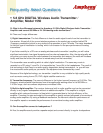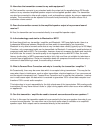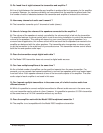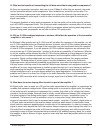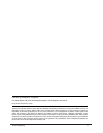
Q: What are the benefits of transmitting the full data rate without using audio compression ?
A: Since our transmitter transmits a data rate of over 3 Mbps (3 million bits per second), the audio
can be transmitted without audio compression. Also, forward error correction can be used. The
reason that other systems use audio compression is to reduce the extremely high data rate of a
pure (uncompressed) audio signal in order to either be able to store that signal or transmit that
signal more easily.
The biggest drawback of using audio compression is that the quality of the audio signal is reduced,
such as in MP3-compressed audio. This is because audio compression removes parts of the music.
Some types of music which are particularly difficult to compress without noticing audio degradation.
Systems using audio compression are not able to deliver CD-quality audio.
Q: Will my 2.4 GHz cordless telephone or wireless LAN affect the operation of the transmitter
/ amplifier or vice versa ?
A: Wireless LANs typically work at 2.4 GHz and will not affect the operation of the amplifier, nor will
any 2.4 GHz cordless phones or Bluetooth devices. However, some 5.8 GHz cordless phones may
cause the amplifier to mute. The range of the transmitter may also be affected during the operation
of other 5.8 GHz equipment. If you do operate a 5.8 GHz cordless telephone, we recommend that
you purchase our 2.4 GHz transmitter / receiver to eliminate any possibility of interference. Whether
or not the amplifier will be affected by other 5.8 GHz devices depends to a large degree on the type
of equipment and the distance between such equipment and the amplifier relative to the audio
transmitter. Digital cordless telephones are more likely to cause problems than analog cordless
telephones. The base station of certain types of cordless telephones, such as the Panasonic
Gigarange series, will periodically broadcast signal beacons, even when the telephone is not in use,
that may cause a clicking noise of the amplifier. Walls located between such equipment and the
amplifier will in many cases attenuate an interfering signal enough for it not to cause any problems
when operating the amplifier. The amplifier employs an error correction scheme and thus can
tolerate interference up to a certain degree without any signal degradation. If interference is a
problem and if there is no direct line-of-sight to the audio transmitter then we recommend the use of
the Model 1550 transmitter which transmits a stronger signal than the Model 1520 transmitter..
Q: What does the noise shaping filter do which is part of the amplifier ?
A: Digital audio, such as audio on a CD and the audio transmitted to the amplifier, is represented by
numbers that represent voltage levels. When analog audio is converted to digital audio, the voltage
of the audio signal is sampled and represented by a number that refers to the voltage that comes
closest to the actual voltage. Because there is usually a small difference between that voltage and
the actual voltage of the analog audio signal, a certain amount of noise - quantization noise - is
introduced. The amount of such quantization noise is, among other things, determined by the
amount of information that is used to represent each sample - resolution. Therefore, digital audio on
a CD and audio transmitted to the receiver always contains a small amount of quantization noise
which limits the maximum possible signal-to-noise ratio of the transmission. In order to increase the
signal-to-noise ration beyond that limit, the receiver features a special noise shaping filter which is a
5th-order filter that outputs the audio at 64 times the sampling frequency and shifts the audio data
quantization noise to higher frequencies that are outside of the audible frequency band. As a result,
the amplifier is able to achieve a higher signal-to-noise ratio than would be possible without a noise
shaping filter.
© 2004 Amphony 4



